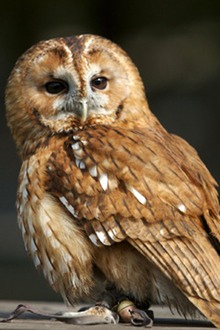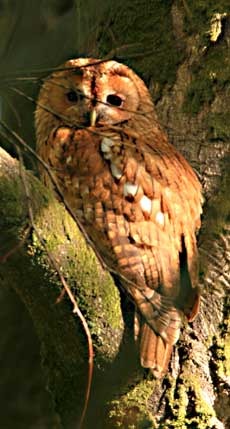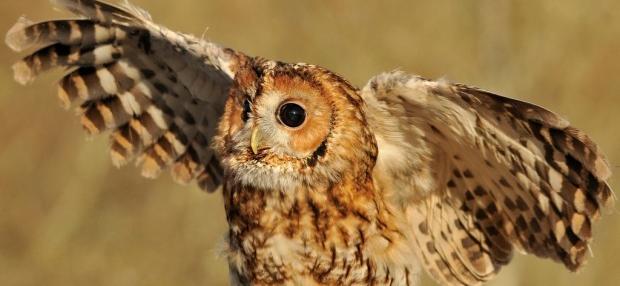
Strix aluco
SUBFAMILY
Striginae, Tribe Strigini
TAXONOMY
Strix aluco Linnaeus, 1758, Sweden. Eleven subspecies are recognized.
OTHER COMMON NAMES
English: Eurasian tawny owl, Eurasian wood-owl, tawny woodowl,
brown owl; French: Chouette hulotte; German: Waldkauz;
Spanish: Cбrabo Comъn.
PHYSICAL CHARACTERISTICS
14.6–15.4 in (37–39 cm). Female, 19.5 oz (553 g). Male, 15.5
oz (440 g). Medium-sized, stocky owl with a large, round head
and blackish brown eyes. Overall color varies from brown to
rufous to gray with intermediates between these hues. Upperparts
are mottled with darker streaks. Underparts are paler,
also dark streaked with variable thin bars. Legs and most of the
gray toes are feathered.
DISTRIBUTION
Great Britain except for Ireland, southern Scandinavia to
North Africa through the Middle East to western Iran; Pakistan,
northwest India, Nepal to southeast China and northern
Indochina, Korea, and Taiwan.
HABITAT
Open forests and woodlands, farmland with woods, parks, urban
areas with parks and gardens.
BEHAVIOR
Sedentary. This is a very vocal owl with wide range of calls.
Chiefly nocturnal.
FEEDING ECOLOGY AND DIET
Wide variety of prey, including mammals (up to the size of
squirrels and small rabbits), birds (up to the size of pigeons),
amphibians, reptiles, insects, and occasionally fish. It has been
known to take smaller owls. Still hunts from a perch; most
prey is located by sound.
REPRODUCTIVE BIOLOGY
Generally nests in cavities, but will use old magpie nests.
Mates for life. Usually lays three to five eggs, but has been
known to lay up to nine. Incubation is 28–30 days. Normally
two young are reared. Young fledge in 32–37 days and are independent
about three months after fledging.
CONSERVATION STATUS
Not globally threatened. Common throughout its range.
SIGNIFICANCE TO HUMANS
None known.
Photo Gallery of - Tawny owl




 Animalia Life
Animalia Life